Industrial Lubricants Market Size
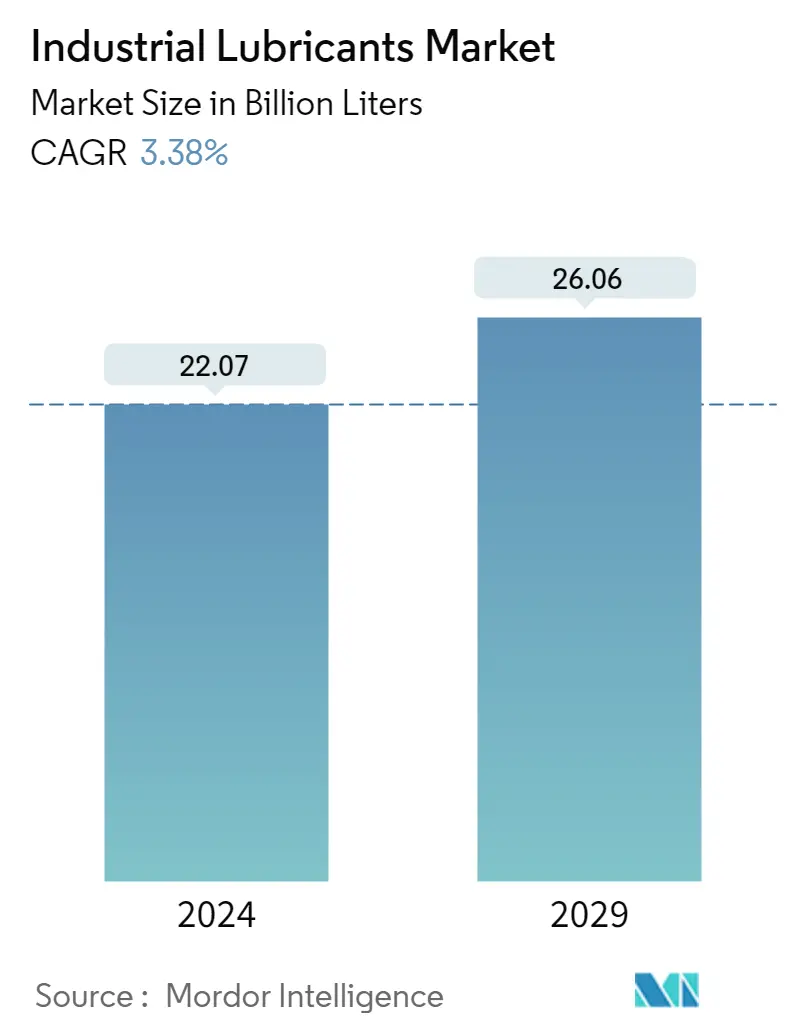
| Study Period | 2018 - 2028 |
| Market Volume (2023) | 21.35 Billion liters |
| Market Volume (2028) | 25.21 Billion liters |
| CAGR (2023 - 2028) | 3.38 % |
| Fastest Growing Market | Asia-Pacific |
| Largest Market | Asia Pacific |
Major Players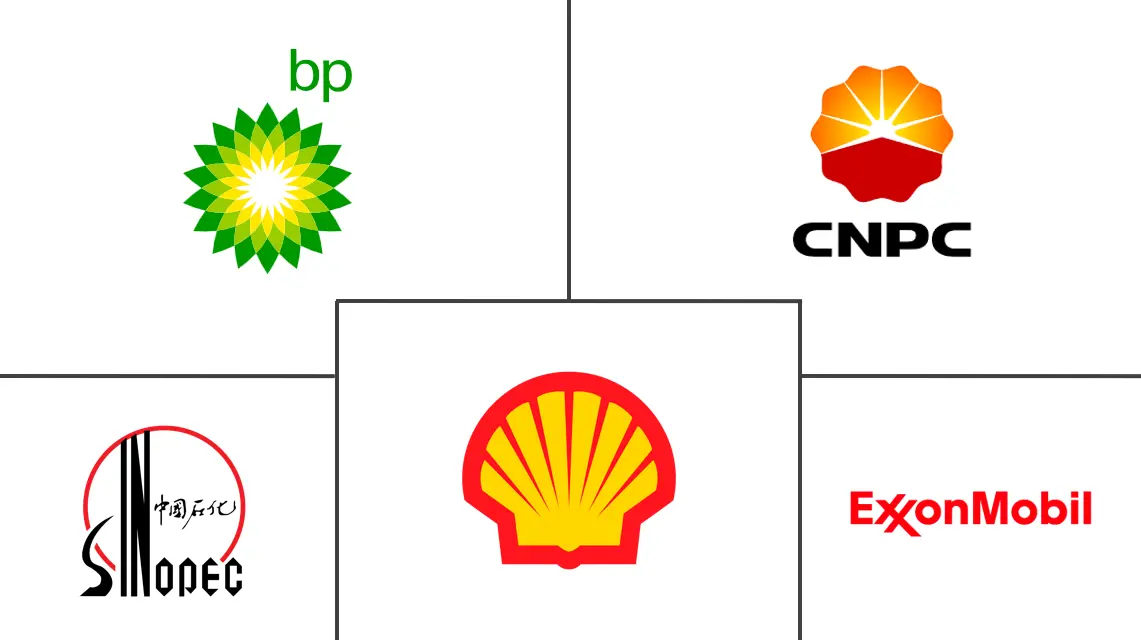
*Disclaimer: Major Players sorted in no particular order |
Need a report that reflects how COVID-19 has impacted this market and its growth?
Industrial Lubricants Market Analysis
The Global Industrial Lubricants Market size is expected to grow from 21.35 billion liters in 2023 to 25.21 billion liters by 2028, at a CAGR of 3.38% during the forecast period (2023-2028).
The market was negatively impacted by COVID-19 in 2020. However, the pandemic has affected the automation process in industrial activities on a large scale in a positive way. The limited availability of manpower due to the pandemic, the need to keep a safe distance in working places, and the use of various personal protective equipment have accelerated the adoption of automation throughout industries. Moreover, the increase in productivity has also increased the run time of the machinery and the speed of the equipment, which has increased the importance of adequate lubrication on the load-bearing surfaces of the equipment, thus enhancing the demand for the studied market.
- Over the short term, increasing demand from the wind energy sector is expected to drive the market's growth.
- However, the detrimental effects of lubricants on the environment are likely to hinder the growth of the market studied.
- Nevertheless, the growing prominence of bio-lubricants and the development of low-viscosity lubricants are likely to act as opportunities for the growth of the market studied.
- Asia-Pacific dominates the market across the world, with the most substantial consumption from countries like China, India, and Indonesia.
Industrial Lubricants Market Trends
This section covers the major market trends shaping the Industrial Lubricants Market according to our research experts:
Power Generation Segment Dominated the Market
- Power generation is one of the most important sectors of the global economy, without which almost all manufacturing operations may cease. Advancements in manufacturing technologies are resulting in the commencement of various new plants, increasing the demand for electricity in various end-user industries.
- Turbines play a key role in the energy sector for generating electricity. Irrespective of the source of electricity, i.e., wind, solar, hydro, thermal, and others, turbines are widely used for power generation. A large amount of heat is emitted from a turbine during the production of electricity. In general, other than turbines, the major components used in the power generation sector include pumps, bearings, fans, compressors, gears, and hydraulic systems. Wind turbines are subjected to many factors, such as humidity, high pressure, high loads, vibrations, and temperature. Gear and turbine oils are widely used in this sector for lubrication purposes.
- Many companies are already aware of the fact that reducing the total cost of ownership (TCO) over the lifetime of machinery is key to extracting the best possible value from the investment. However, the impact of lubrication on the TCO is underestimated too often.
- In general, the cost of lubricants accounts for less than 5% of a power generation company’s total operational expenditure. According to an industry survey, about 58% of the companies recognized that lubricant selection could help reduce costs by 5% or more, but fewer than 1 in 10 (8%) companies realized that the impact of lubrication could be up to six times more.
- In hydroelectric power generation, lubricants are used for air compressors, gears, turbines, circulating oil systems, hydraulics, and bearings, among other purposes. The lubricants consumed include greases, general lubricating oils, transmission oils, turbine oils, and hydraulic oils, among others. In nuclear power plants, lubricants (turbine oils) are used mainly for steam turbines for better efficiency.
- In coal-fired power plants, lubricants are used for air compressors, hydraulics, turbines, mobile equipment, bearings, and gears. Coal excavator systems also consume different types of lubricants, including gear oils, greases, transmission oils, and hydraulic oils. Coal-fired power plants consume high-temperature and heavy-duty lubricants.
- Hence, all such factors and trends are expected to drive the demand for lubricants, post the global economic recovery from the pandemic.
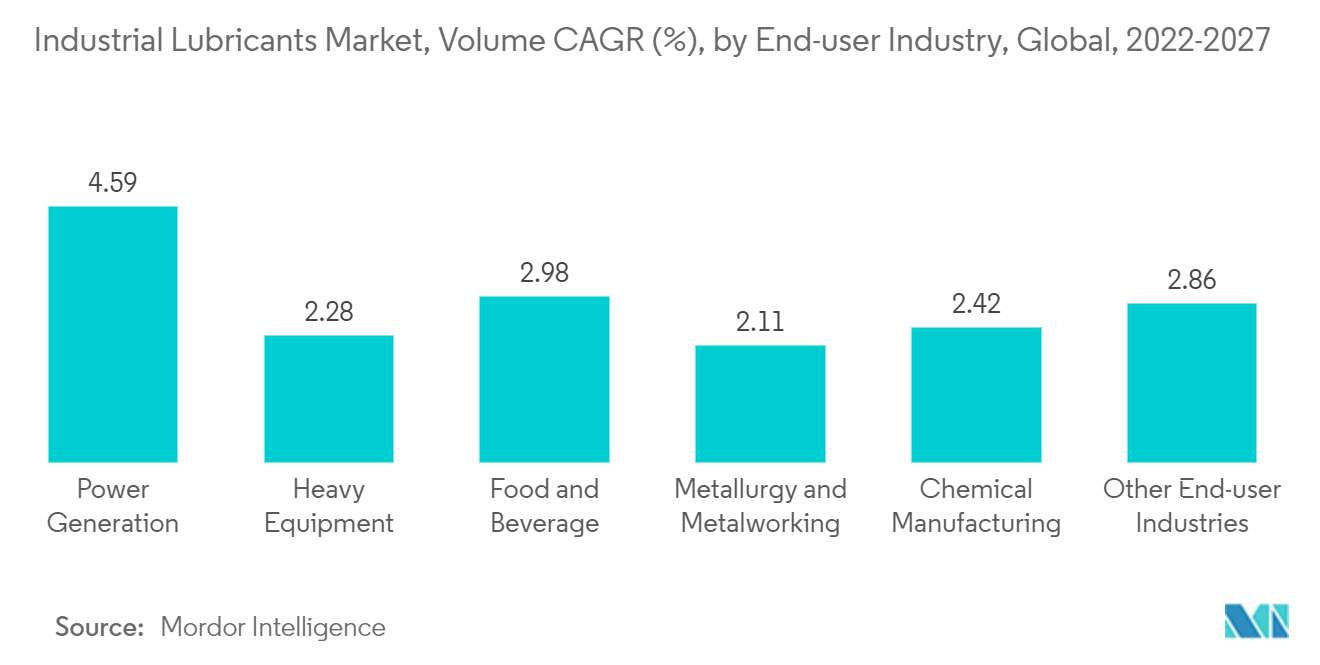
Asia-Pacific Region to Dominate the Market
- Asia-Pacific was found to be the major market for the consumption of lithium, owing to increasing consumption from countries such as China, India, and Indonesia.
- China is the largest consumer of lubricants and greases in the current scenario. The vast manufacturing activities pertaining to different sectors and the rapid growth in the industrial and automotive sectors have pushed the country to stand among the major lubricant consumers and producers in the global landscape.
- In 2021, China's top economic planner sanctioned 90 fixed-asset investment projects, helping increase development. In 2021, the National Development and Reform Commission approved USD 122 billion in investment projects, mostly in the transportation, energy, water conservation, and information technology sectors. According to the current statistics, China's fixed-asset investment increased by 4.9% Y-o-Y to over CNY 54.45 trillion (~ÙSD 7.68 trillion) in 2021, up 8% from the same period in 2019. With enhanced fiscal and monetary support beyond 2021, the country has the potential and incentive to expand effective investments.
- In addition, China has been focusing on new infrastructure, with construction being the majority type of fixed assets, in the near future. Such growth in construction activity is expected to be witnessed in the future, owing to increased expenditure and the government’s focus on infrastructure growth.
- The China Association of Automobile Manufacturers (CAAM) reported cumulative motor vehicle production levels for 2021, which were 26.082 million units, up by 3.4% Y-o-Y. CAAM predicts the motor vehicle market may continue to record steady growth in 2022 and beyond.
- India is the second-largest lubricant consumer in the region and the third-largest in the world, after the United States and China. The country accounts for about 7% of the demand in the global lubricants market. While the industrial lubricants market is fragmented in nature, the Indian grease market is highly consolidated in nature, with the top five players accounting for more than 75% of the market share.
- Favorable government policies, such as the extension of the FAME-II scheme until 2024, the enhancement of incentives for two-wheelers, the launch of the production-linked incentive (PLI) scheme for the auto and auto component sector (worth INR 26,000 crore (~USD 3.20 billion)), and the PLI for advanced chemistry cell worth INR 18,000 crore (~USD 2.22 trillion), are likely to provide significant support to the sector as it adopts advanced technologies.
- Indonesia (the world’s fourth-largest populated country) has been among the potential lubricants markets in recent years on account of its huge population, high urbanization, and rapidly rising middle class. Sectors such as mining, textile, and infrastructure have been driving the consumption of industrial lubricants in the recent past.
- According to the Indonesian Food and Beverage Entrepreneurs Association (GAPMMI), the food and beverage industry is estimated to rise by 7% by 2021. As per Badan Pusat Statistik (Statistics Indonesia), the production output from large and medium manufacturing industries exhibited a negative growth of 8.01% in 2021.
- The Government of Indonesia has been planning to invest about USD 412 billion in building projects, including constructing 25 airports, residential complexes, etc., by 2024. Such investments are part of the government’s target to seek to strengthen growth in the country. However, the disruption in the supply chain is expected to hinder the initially expected growth path of the sector in the short term.
- Therefore, all the aforementioned factors are likely to significantly impact the market studied in the future.
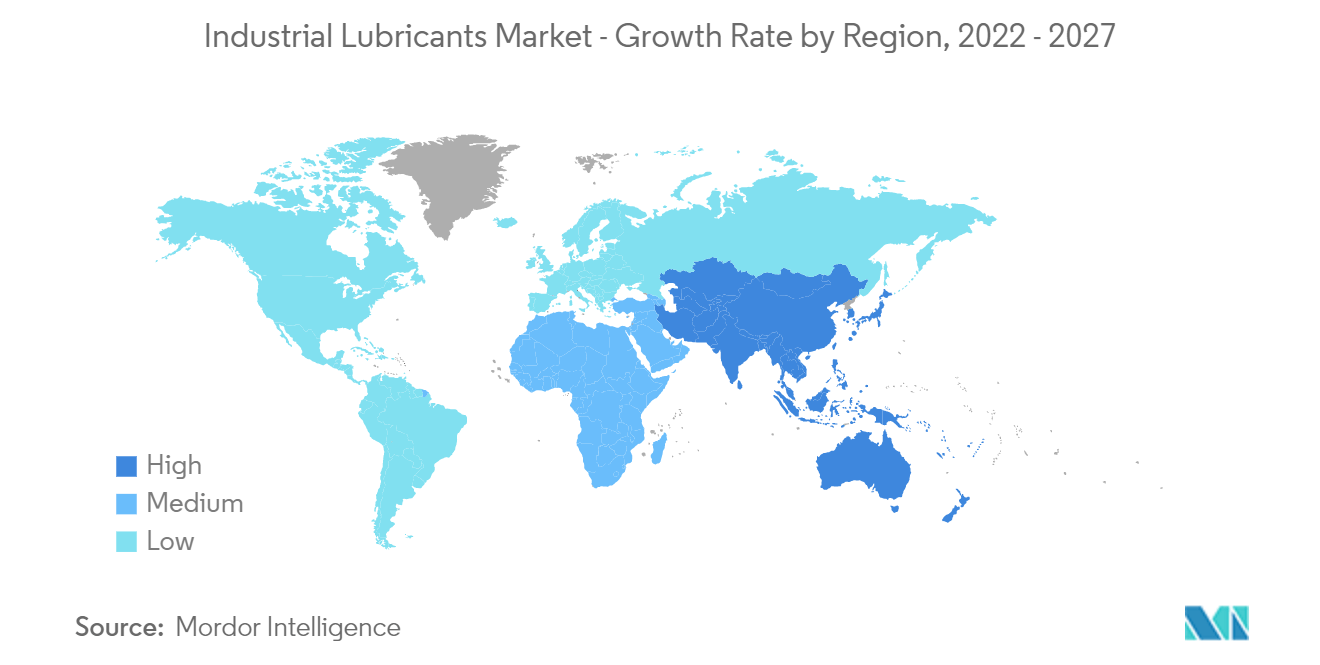
Industrial Lubricants Industry Overview
The global industrial lubricants market is fragmented in nature. Some of the key players in the market include Royal Dutch Shell PLC, Exxon Mobil Corporation, China Petroleum & Chemical Corporation, China National Petroleum Corporation, and BP PLC (Castrol), among other companies.
Industrial Lubricants Market Leaders
BP PLC (Castrol)
Exxon Mobil Corporation
Royal Dutch Shell PLC
China National Petroleum Corporation
China Petroleum & Chemical Corporation
*Disclaimer: Major Players sorted in no particular order
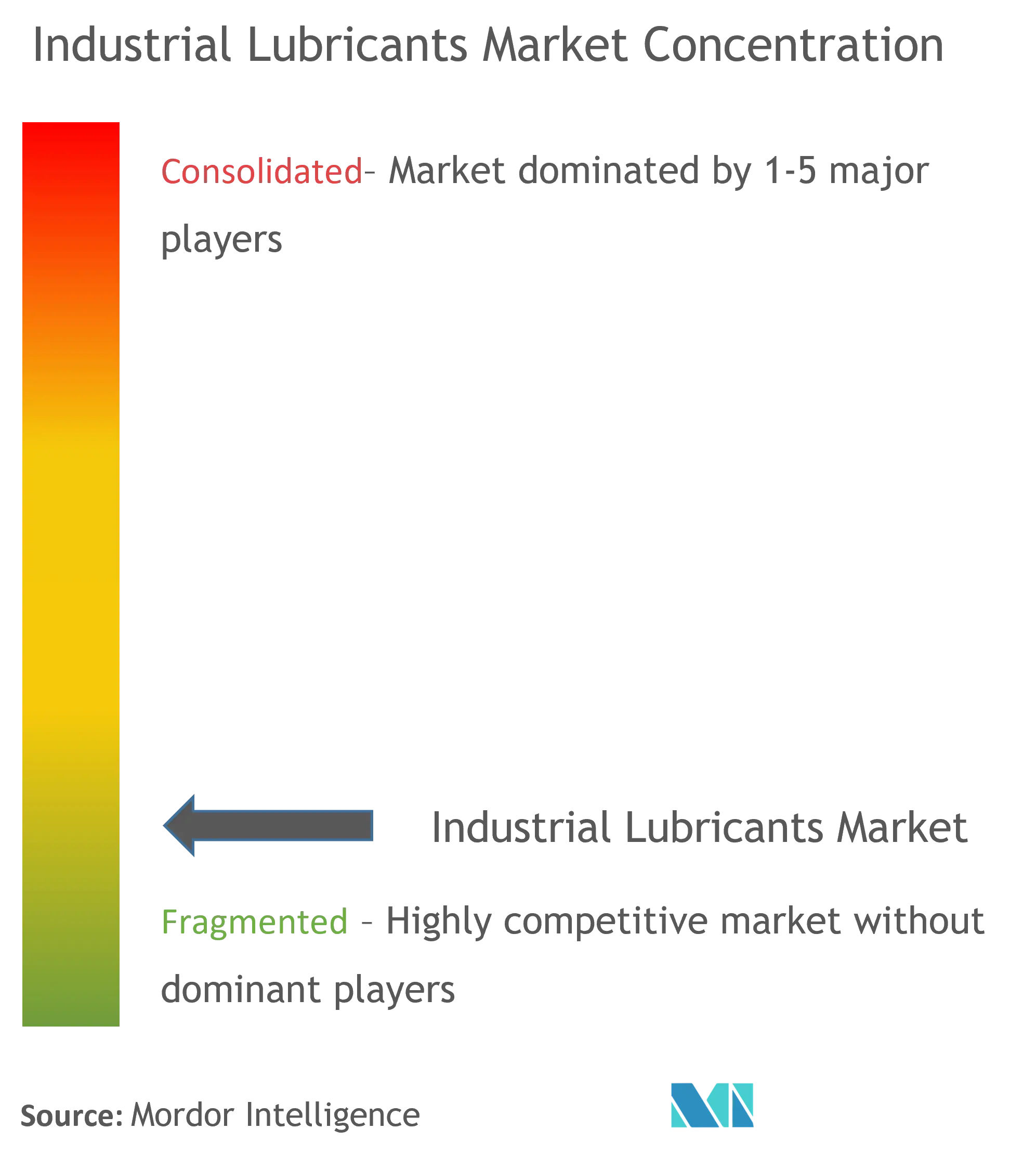
Industrial Lubricants Market News
- January 2022: Chevron Lubricants Lanka PLC, a subsidiary of Chevron Corporation, announced a marketing deal with Rock Energy in Bangladesh for its lubricant products.
- December 2021: The joint venture agreement between Castrol, BP, and Vietnam National Petroleum Group (Petrolimex) was extended for another 20 years, from 2022 to 2042. Castrol BP Petco Co. Ltd is the name of the joint venture company.
- November 2021: Bharat Petroleum Corporation Limited, Indian Oil, and Hindustan Petroleum Corporation Limited announced the commencement of the Model Retail Outlet Scheme and the Darpan-Petrol Pump Digital Customer Feedback Program. Three oil PSUs collaborated to develop model retail outlets to improve service standards and facilities throughout their networks, which serve over six crore consumers daily.
Industrial Lubricants Market Report - Table of Contents
1. INTRODUCTION
1.1 Study Assumptions
1.2 Scope of the Study
2. RESEARCH METHODOLOGY
3. EXECUTIVE SUMMARY
4. MARKET DYNAMICS
4.1 Drivers
4.1.1 Increasing Demand from the Wind Energy Sector
4.1.2 Other Drivers
4.2 Restraints
4.2.1 Detrimental Effects of Lubricants on the Environment
4.3 Industry Value Chain Analysis
4.4 Porter's Five Forces Analysis
4.4.1 Bargaining Power of Suppliers
4.4.2 Bargaining Power of Consumers
4.4.3 Threat of New Entrants
4.4.4 Threat of Substitute Products and Services
4.4.5 Degree of Competition
5. MARKET SEGMENTATION
5.1 Product Type
5.1.1 Engine Oil
5.1.2 Transmission and Hydraulic Fluid
5.1.3 Metalworking Fluid
5.1.4 General Industrial Oil
5.1.5 Gear Oil
5.1.6 Grease
5.1.7 Process Oil
5.1.8 Other Product Types
5.2 End-user Industry
5.2.1 Power Generation
5.2.2 Heavy Equipment
5.2.3 Food and Beverage
5.2.4 Metallurgy and Metalworking
5.2.5 Chemical Manufacturing
5.2.6 Other End-user Industries
5.3 Geography
5.3.1 Asia-Pacific
5.3.1.1 China
5.3.1.2 India
5.3.1.3 Japan
5.3.1.4 South Korea
5.3.1.5 Phillipines
5.3.1.6 Indonesia
5.3.1.7 Malaysia
5.3.1.8 Thailand
5.3.1.9 Vietnam
5.3.1.10 Rest of Asia-Pacific
5.3.2 North America
5.3.2.1 United States
5.3.2.2 Canada
5.3.2.3 Mexico
5.3.2.4 Rest of North America
5.3.3 Europe
5.3.3.1 Germany
5.3.3.2 United Kingdom
5.3.3.3 Italy
5.3.3.4 France
5.3.3.5 Russia
5.3.3.6 Turkey
5.3.3.7 Spain
5.3.3.8 Rest of Europe
5.3.4 South America
5.3.4.1 Brazil
5.3.4.2 Argentina
5.3.4.3 Colombia
5.3.4.4 Chile
5.3.4.5 Rest of South America
5.3.5 Middle East
5.3.5.1 Saudi Arabia
5.3.5.2 Iran
5.3.5.3 Iraq
5.3.5.4 United Arab Emirates
5.3.5.5 Kuwait
5.3.5.6 Rest of Middle East
5.3.6 Africa
5.3.6.1 Egypt
5.3.6.2 South Africa
5.3.6.3 Nigeria
5.3.6.4 Algeria
5.3.6.5 Morocco
5.3.6.6 Rest of Africa
6. COMPETITIVE LANDSCAPE
6.1 Mergers, Acquisitions, Joint Ventures, Collaborations, and Agreements
6.2 Market Share (%) Analysis
6.3 Strategies Adopted by Leading Players
6.4 Company Profiles
6.4.1 Amsoil Inc.
6.4.2 Bharat Petroleum Corporation Limited
6.4.3 Blaser Swisslube AG
6.4.4 BP PLC (Castrol)
6.4.5 Carl Bechem GmbH
6.4.6 Chevron Corporation
6.4.7 China National Petroleum Corporation (PetroChina)
6.4.8 China Petroleum & Chemical Corporation (SINOPEC Group)
6.4.9 Eni SpA
6.4.10 Exxon Mobil Corporation
6.4.11 FUCHS
6.4.12 Gazprom Neft PJSC
6.4.13 Gulf Oil International
6.4.14 HPCL
6.4.15 Idemitsu Kosan Co. Ltd
6.4.16 Indian Oil Corporation Ltd
6.4.17 ITW (ROCOL)
6.4.18 ENEOS
6.4.19 Kluber Lubrication
6.4.20 Lukoil Lubricants Company
6.4.21 PT Pertamina
6.4.22 Petrobras
6.4.23 Petronas Lubricants International
6.4.24 Phillips 66 Lubricants
6.4.25 Repsol
6.4.26 Royal Dutch Shell PLC
6.4.27 Tide Water Oil Co. (India) Ltd
6.4.28 TotalEnergies
6.4.29 Valvoline Inc.
- *List Not Exhaustive
7. MARKET OPPORTUNITIES AND FUTURE TRENDS
7.1 Growing Prominence for Bio-Lubricants
7.2 Development of Low Viscosity Lubricants
Industrial Lubricants Industry Segmentation
A lubricant is a substance that is applied to surfaces that have relative motion between them. Lubricant reduces friction and wears between surfaces. However, in addition to these primary functions, a lubricant can have other functions. Some of the other roles include sealing agent, heat transfer agent, and corrosion prevention agent. Lubricants can be found in many forms, from liquid, semi-solid, dry and gaseous lubricants, etc. The most common lubricants are oils and gases. The global industrial lubricants market is segmented by product type, end-user industry, and geography. By product type, the market is segmented into engine oil, transmission and hydraulic fluid, metalworking fluid, general industrial oil, gear oil, grease, process oil, and other product types. By end-user industry, the market is segmented into power generation, heavy equipment, food and beverage, metallurgy and metal working, chemical manufacturing, and other end-user industries. The report also covers the market size and forecasts for the industrial lubricants market in 33 countries across major regions. For each segment, the market sizing and forecasts have been done on the basis of volume (million liters).
| Product Type | |
| Engine Oil | |
| Transmission and Hydraulic Fluid | |
| Metalworking Fluid | |
| General Industrial Oil | |
| Gear Oil | |
| Grease | |
| Process Oil | |
| Other Product Types |
| End-user Industry | |
| Power Generation | |
| Heavy Equipment | |
| Food and Beverage | |
| Metallurgy and Metalworking | |
| Chemical Manufacturing | |
| Other End-user Industries |
| Geography | ||||||||||||
| ||||||||||||
| ||||||||||||
| ||||||||||||
| ||||||||||||
| ||||||||||||
|
Industrial Lubricants Market Research FAQs
How big is the Industrial Lubricants Market?
The Industrial Lubricants Market size is expected to reach 21.35 billion liters in 2023 and grow at a CAGR of 3.38% to reach 25.21 billion liters by 2028.
What is the current Industrial Lubricants Market size?
In 2023, the Industrial Lubricants Market size is expected to reach 21.35 billion liters.
Who are the key players in Industrial Lubricants Market?
BP PLC (Castrol), Exxon Mobil Corporation, Royal Dutch Shell PLC, China National Petroleum Corporation and China Petroleum & Chemical Corporation are the major companies operating in the Industrial Lubricants Market.
Which is the fastest growing region in Industrial Lubricants Market?
Asia-Pacific is estimated to grow at the highest CAGR over the forecast period (2023-2028).
Which region has the biggest share in Industrial Lubricants Market?
In 2023, the Asia Pacific accounts for the largest market share in the Industrial Lubricants Market.
Industrial Lubricants Industry Report
Statistics for the 2023 Industrial Lubricants market share, size and revenue growth rate, created by Mordor Intelligence™ Industry Reports. Industrial Lubricants analysis includes a market forecast outlook to 2028 and historical overview. Get a sample of this industry analysis as a free report PDF download.
